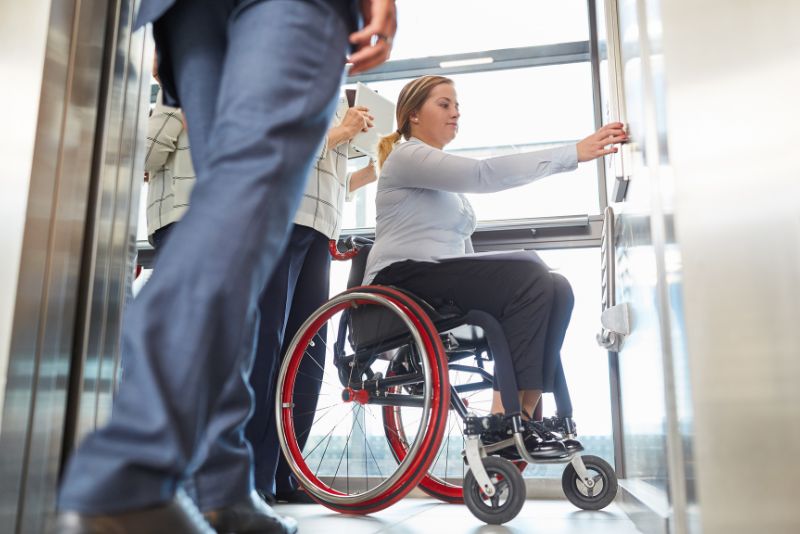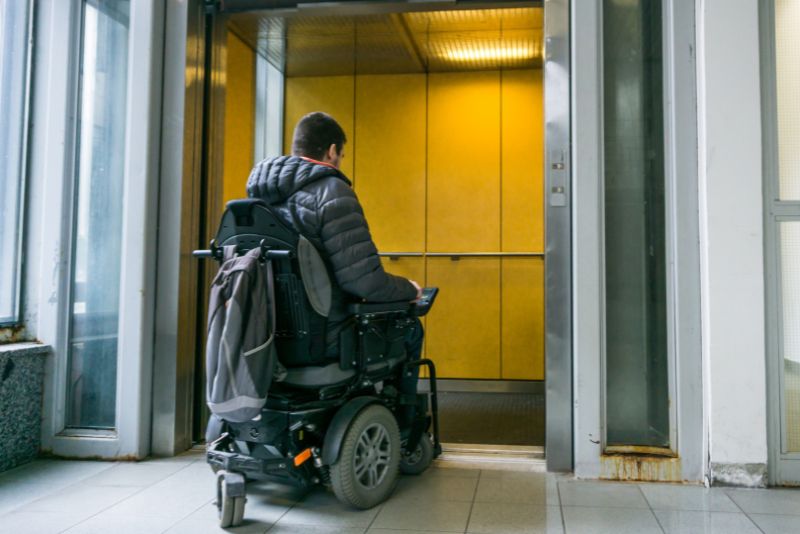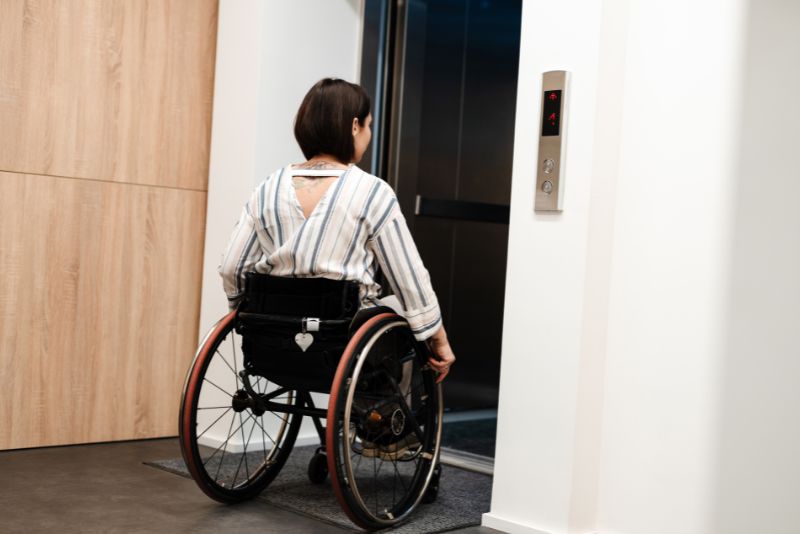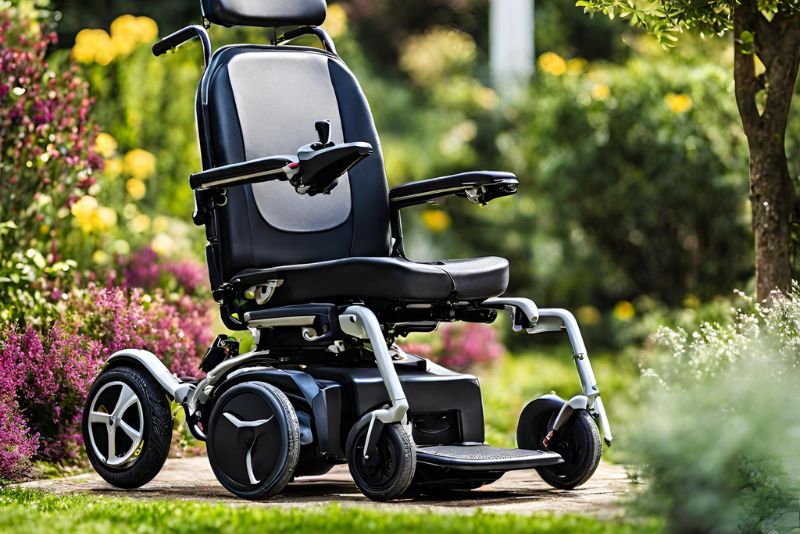Moving a wheelchair onto an elevator can be tricky, but it’s essential for maintaining accessibility. The ADA recommends at least 32 inches of clear width in elevators for a single wheelchair to maneuver comfortably.(1)
Our guide outlines the safest and most efficient methods to get this done. Keep reading—we’ve got the tips you need!
The Importance of Properly Moving a Wheelchair Onto an Elevator

Getting a wheelchair on an elevator is more than just getting from point A to point B. It is a critical matter of safety and respect for the equipment. To avoid potential risks, ensure the rider and the wheelchair are secure, keeping everyone safe and valuable assets out of harm’s way.
Ensuring Safety for The Wheelchair User
Safety comes first for wheelchair users getting onto an elevator. Always check the wheelchair’s brakes before entering; they must fully work to prevent rolling. Make sure ramps and lifts allow the chair to face both in and out, following safety rules.
Caregivers should know the user’s weight and health status to avoid accidents. They need to use patient lifts correctly, according to the maker.
Helping a person from their wheelchair onto another surface needs care too. This might be a seat in the elevator or moving onto a stretcher. It involves two steps and is very important in hospitals.
Nurses and healthcare staff should be trained to do this safely every time. Good transfer techniques are key for keeping patients happy and safe.
Avoiding Damage to The Elevator Or Wheelchair

Take care when moving a wheelchair into an elevator. Make sure not to bump into walls or doors. Doing so can cause scratches or dents on the elevator and may cause damage to the wheelchair. Additionally, ensure that nothing on the wheelchair catches on any parts of the lift.
Loose items could get stuck and cause problems.
Always use the brakes on the wheelchair before going in or out of elevators. This stops sudden moves and keeps control. If you’re using an electric wheelchair, turn off the power before entering to avoid unexpected jerks or motions.
Damage is less likely when everything is steady and secure.
The Different Ways to Move a Wheelchair Onto an Elevator

Getting from the ground to an elevator in a wheelchair, whether alone or with help, needs the right method and attention. Let’s look at how to do this safely and easily, with and without assistance.
Attendant Operation with Assistance
If you’re moving a wheelchair onto an elevator with help, make sure the person assisting knows how to operate the lift properly. They need to follow elevator safety rules and be familiar with ADA requirements.
The attendant should stand before the wheelchair and back it into the elevator. This way, they can use their strength to guide it over any bumps or thresholds.
The person helping must also secure the brakes once on the elevator. Safety for everyone comes first, so never rush this process. Check that there’s enough room for others and that emergency buttons are within reach if needed.
With careful teamwork, you’ll get onto elevators smoothly while keeping risks low for all involved.
Pushing Without Assistance
Moving a wheelchair onto an elevator alone takes care. Slowly approach the elevator door with the wheelchair user facing forward. Make sure to lock the wheelchair brakes before entering.
Lower the front wheels first, then push steadily and firmly to move over the threshold. Keep movements smooth to stay safe and avoid jerks.
Be mindful of your own body mechanics while pushing. Stand straight and use your leg muscles instead of straining your back. Ensure there’s room in the elevator for both you and the wheelchair user without crowding others.
Stay inside the alarm button in case you need it during this process.
Tips for Successfully Moving a Wheelchair Onto an Elevator

Navigating the journey onto an elevator in a wheelchair can be smooth sailing with the right approach. We’re about to dive into some savvy tips that’ll keep you rolling—safely and efficiently—onto your next vertical adventure.
Positioning the wheelchair correctly
Positioning the wheelchair correctly is crucial for entering an elevator safely. Make sure the user leans forward slightly and pushes their hips back, aligning with their knees. This helps to tilt the wheelchair back just a bit, making it easier to maneuver without straining.
It’s important because proper position prevents injuries and avoids putting extra stress on the wheelchair.
Ease the chair onto the elevator by carefully lining up its wheels with the door. A smooth entry ensures that neither the wheelchair nor the elevator is damaged during this process.
Always double-check that there’s enough room inside before moving in, allowing for a comfortable fit without bumping into others or the walls.
Using appropriate strength
Push the wheelchair with enough force to move it smoothly onto the elevator. Locking the wheels once inside is vital for safety. This prevents rolling or sliding as the elevator moves.
If you push too hard, you might hit the walls or other people if it’s crowded. Be gentle and steady to keep everyone safe.
Check that nothing is in your way before moving forward. Tight spaces need extra care, so use a softer touch here. For wheelchairs with power seat elevation devices, adjust them if needed to fit properly inside the elevator cabin without bumping into things.
This keeps both equipment and health system quality high by avoiding damage and accidents.
Considering the terrain
Check the ground before rolling a wheelchair onto an elevator. Look for bumps, rugs, or wet spots that could cause trouble. Wheelchairs need a clear path to move safely and smoothly.
If you find something in your way, steer around it or ask someone to help clear the space.
Our outdoor electric wheelchairs are designed to adapt to various terrains, offering enhanced stability and ease of navigation. Even so, it’s important to remain cautious and vigilant in all environments, especially when transitioning to different surfaces like an elevator.
Make sure to adjust your approach based on what you see. Is the floor sloped? Are there thresholds or small steps? These might make it harder to push a wheelchair onto the elevator.
Slow down if needed and take care when going over uneven spots. Your main goal is safe entry onto the elevator so everyone stays happy and unharmed.
Common Mistakes to Avoid

Navigating the common pitfalls when moving a wheelchair onto an elevator is key; these missteps can lead to discomfort or even danger for the user. From overstuffing elevators to ignoring emergency protocols, we’ll delve into how these easily overlooked errors can affect the ride—stay tuned, because what you learn here might just streamline your next lift experience!
Getting onto a full elevator
Waiting for a less crowded elevator is key. Full elevators can be tricky and unsafe for wheelchair users. Ensure there’s enough space to roll in without bumping into others or the walls.
Elevators should fit wheelchairs comfortably, so waiting if one is packed is better.
Stay clear of elevator doors if you use a mobility aid like a wheelchair or walker. If an elevator looks too small, don’t squeeze in. It might block your way out and make it hard for others too.
Always check that there’s plenty of room before entering.
Not being close to the alarm button.
Stay near the alarm button when in an elevator. This is a key safety tip for wheelchair users. If the elevator stops or something goes wrong, you must reach this button quickly. It calls for help and alerts others that you are in trouble.
Being close to it makes sure you can get quick assistance.
Make it a point to check where the alarm button is as soon as you enter an elevator. You or your caregiver should move the wheelchair so that this button is within easy reach. This way, if there’s an emergency, you won’t waste precious time trying to find it.
Quick access could mean faster help and less stress in a tough situation.
Facing backward in the elevator
Turning your back to the elevator door in a wheelchair isn’t safe. It makes it hard to see when you reach your floor and move out quickly. This can block other people from getting off or onto the elevator and could cause bumps and crashes.
Always face forward so you can steer clear of accidents.
Make sure the wheelchair is facing toward the doors as they open. This will help with smooth exits and keep everyone on track, including those with disabilities. Moving this way also lets the person in the chair see where they’re going, which is important for feeling confident and secure during their ride.
Not asking for help
Sometimes moving a wheelchair onto an elevator can be tricky. You might think you can do it alone, but asking for help is often safer. A friend or someone nearby can ensure the wheelchair enters smoothly without hitting the sides.
They can also assist by pressing the button or holding doors open.
Letting pride get in the way could lead to accidents. Always lock the brakes and lift footplates before entering an elevator to prevent tipping over or sliding. If you’re unsure, don’t hesitate to ask for assistance — it’s better than risking injury or causing damage to your chair! People are usually happy to lend a hand because everyone deserves safe and easy access everywhere they go.
Additional Considerations

In exploring the nuances of wheelchair mobility, it’s crucial to delve into the diverse needs presented by different wheelchair designs and individual user circumstances. Let’s look beyond basic movement—addressing transitions from wheelchairs to alternate seating can significantly enhance accessibility and comfort for users in varied environments.
Accessibility for different wheelchair designs
Elevators must accommodate all types of wheelchairs, from manual to power models and scooters. Lifts need to have enough space for different sizes and designs. This way, whether a person uses a compact chair or a larger one with advanced features, they can still use the elevator quickly and comfortably.
Covered entities are required by law to ensure people with disabilities have access. They must use lifts that fit both their wheelchairs and their companions. This ensures health equity and quality of care for everyone who relies on wheelchairs for mobility.
Assisting the user from the wheelchair to another surface
Helping someone move from their wheelchair to a different surface needs care and skill. First, talk with the person to understand what they need. Make sure they can stand on at least one leg if that’s part of the plan.
Have them put their hands on the armrests, not on you, and push up. This keeps both of you safe.
Using seat elevation systems can make transfers smoother. These systems lift the chair so it’s easier for users to reach beds or other surfaces at home. Nurses and caregivers get training in proper transfer techniques for patient satisfaction and safety.
Always consider each person’s unique needs when moving them from wheelchairs to ensure comfort and avoid medical errors.
Conclusion
Moving a wheelchair onto an elevator needs care and the right steps. Always face the user toward the door, pull from behind if you’re assisting, and don’t rush. Check for space on the elevator before entering.
Remember these tips to make sure every ride is safe and smooth!
For an easier experience, check out Yveelt Medical’s electric wheelchairs. They’re designed for safety and comfort. Join us and improve your mobility with us!






